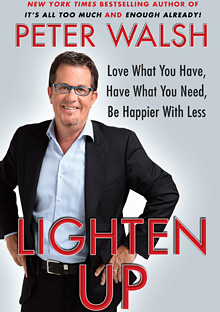Excerpt from Lighten Up

Clear the Financial and Emotional Clutter - Start With Your Home
That Clutter Is Costing Real DollarsIt's easy to put a dollar figure on the cost of professionally stored clutter, but what about the clutter you keep at home? How much is that costing you? I'm not just referring to the financial cost. I'm also talking about what it's costing you emotionally. The emotional cost may exceed the dollar cost.
Try going through one room and make a quick estimate of the cost of what you're not using. For example, look in your bedroom and consider the cost of unworn clothes and shoes, unread books, unworn jewelry, or unused makeup. Consider the unused toys in your den or child's bedroom. If any particular item you come across tugs at your heart or makes you emotional, then consider that an added cost. Add up the cost of the items—I'm guessing that some of those clothes still have the tags on them so it won't be that hard—and write down the amount. Is it big? How much of that are you still paying off? This simple exercise should give you a rough estimate of the cost of the clutter in your home.
Another assessment you can do is to work out how much each square foot of your home is worth and then see how much of that space is unused due to clutter. Simply take the current value of your home (make a rough estimate; you're not trying to come up with the exact selling figure for real estate purposes so just obtain the general ballpark figure), and determine how much each square foot is worth.
Value of your home ÷ Square footage of your home = Value of each square foot
____________ ÷ _______________ = ____________
So, if you live in a $250,000 home and it's 2,500 square feet, then each square foot is worth $100.
The value of each square foot of my home is: ____________
Now let's calculate how much of your home's space is occupied by things you don't use. Walk around your home and make a rough calculation of how many square feet are unusable because of the clutter. Don't forget the basement, closets, and garage!
The number of square feet in my home that are occupied by things I don't use: ______________
Now let's find out how much that wasted square footage is worth:
Value of square footage × Square feet occupied by things you don't use = Value of unusable space:
____________ X _______________ = ____________
Are you surprised at the value of the space you're giving up to things you don't use? Is it a big waste of space? A colossal waste of money for space that is lost to you and your family? Every month when you pay your mortgage company, a decent chunk of that money is paying for storage in your own home.
Now let's do this once more but this time go through and write down what everything in each room is worth. Mark which items have been totally paid for. And then write down how much you still owe on the other items. For example, let's say you have a big-screen TV that you bought for $2,000 when it first came out because you had to have it for the Super Bowl three years ago. Did you put it on your credit card? Have you paid the card off or are you carrying a balance every month? Think about it: if you are carrying a balance, some part of the balance you pay every month is that TV you bought three years ago. If that TV breaks, you are still paying it off even if you replace it. And then you'll be paying for both the broken TV and its replacement! Really look around your house and figure out exactly what you own and what you still owe money on. Was anything worth the worry and stress of those monthly bills?
5 strategies to clear everyday clutter
ABOUT THE AUTHOR
Peter Walsh is a clutter expert and organizational consultant who characterizes himself as part contractor and part therapist. He is a regular guest on The Oprah Winfrey Show and hosts Enough Already! with Peter Walsh on the Oprah Winfrey Network (OWN). Peter holds a master's degree with a specialty in educational psychology. He divides his time between Los Angeles and Melbourne, Australia.
Excerpted from Lighten Up by Peter Walsh. Copyright ©2011 by Peter Walsh Design, Inc. Excerpted with permission by Free Press, a Division of Simon & Schuster, Inc.



